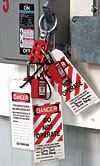
That is exactly the sort of terrifying scenario that lockout/tagout is meant to prevent. Lockout/tagout is a procedure to disable equipment to protect workers from either an unexpected release of energy or an accidental start-up while performing job activities.
When the Occupational Safety and Health Administration (OSHA) revealed the 10 most-violated OSHA standards, based on citations issued from Oct. 1, 2004, through Aug. 30, 2005, the fifth most-cited standard was lockout/tagout.
"Obviously, companies should comply with lockout/tagout regulations so they do not receive citations and fines from OSHA," said Benjamin Mangan, president and founder of MANCOMM and American Safety Training Inc., two companies that work together to provide OSHA compliance products and safety training. "But most importantly, companies should comply because lockout/tagout prevents accidents and saves lives."
LOCKOUT/TAGOUT IN THE WORKPLACE
Lockout/tagout is required when servicing or performing maintenance on equipment. Effective lockout/tagout should occur in three phases: applying lockout/tagout, servicing and repairing equipment, and returning equipment to proper operation.
Since 1996, MANCOMM and American Safety Training Inc. have been committed to helping businesses protect their workers by providing safety products and training. For more information, visit www.mancomm.com.
Sidebar: Test Your Knowledge
How familiar are you with lockout/tagout? Take this test and find out.
1. What is the purpose of lockout/tagout?
a) To make sure the work is being completed on time.
b) To protect people from serious harm due to accidental release of energy.
c) To make sure the workplace is secure after-hours.
d) To make sure employees are in top physical condition.
2. What is an energy-isolating device?
a) A lock
b) A mechanical device like a valve or a circuit breaker
c) A tag
d) A and C
3. Who can service equipment?
a) Any employee
b) Management
c) Authorized workers
d) Custodians
4. What must happen before removing a machine guard?
a) You must put on eye protection.
b) Ask a trusted co-worker to watch the controls so no one else will touch them.
c) Tell everyone you see in the work area they need to be especially careful.
d) Lockout/tagout the equipment.
5. What is a tag used for?
a) To hang around a worker's neck.
b) To identify company products.
c) A warning to not operate equipment.
d) None of the above
6. When are tags used?
a) When a lock cannot be used.
b) When products go on sale.
c) When a government official says they can be used.
d) All of the above.
7. You can help an authorized person by fastening their lock to a disconnect switch. True or false?
8. What kind of lock is used for lockout?
a) A lock from the worker's personal locker.
b) A piece of strong wire.
c) Hand cuffs.
d) A lock specifically identified for lockout.
9. What is used to remove a lock from an isolating device?
a) A hacksaw.
b) A key.
c) Bolt cutters.
d) A cutting torch.
10. What types of lockout/tagout records should be kept?
a) Written lockout/tagout procedure.
b) Inspection documents.
c) Training records.
d) All of the above.
ANSWERS: 1. b; 2. b; 3. c; 4. d; 5. c; 6. a; 7. f; 8. d; 9. b; 10. d.
Publication date: 06/05/2006

Report Abusive Comment